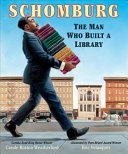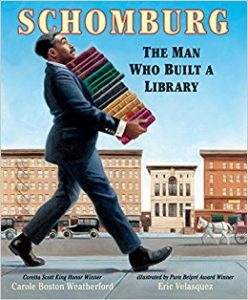Reviewed by Deborah Menkart
Review Source: Teaching for Change
Book Author: Carole Boston Weatherford
“Where is our historian to give us our side? To teach our people our own history?” asks Afro-Puerto Rican Arturo Schomburg on the first page of this beautifully illustrated picture book. Schomburg’s 5th-grade teacher had told him “Africa’s sons and daughters had no history, no heroes worth noting.” Schomburg dedicated his life to ensuring that future generations would learn of Africa and African Americans’ powerful heritage. He set out to write, research, and collect the stories that chronicled the Black history of the Diaspora. Filling every nook and cranny of his family home in Harlem, his collection was eventually donated to the now famous Schomburg Center for Research in Black Culture in New York.
Read additional review from Shelf Awareness here.


Schomburg: the Man Who Built a Library by Carole Boston Weatherford
Illustrator: Eric Velasquez
Published by Candlewick Press on 2017-09
Genres: African American
Pages: 48
Reading Level: Grades 3-5, Grades 6-8
ISBN: 9780763680466
Review Source: Teaching for Change
Also by this author: Voice of Freedom, Unspeakable, How Do You Spell Unfair?: MacNolia Cox and the National Spelling Bee
Publisher's Synopsis: In luminous paintings and arresting poems, two of children's literature's top African-American scholars track Arturo Schomburg's quest to correct history.
Where is our historian to give us our side? Arturo asked.
Amid the scholars, poets, authors, and artists of the Harlem Renaissance stood an Afro-Puerto Rican named Arturo Schomburg. This law clerk's life's passion was to collect books, letters, music, and art from Africa and the African diaspora and bring to light the achievements of people of African descent through the ages. When Schomburg's collection became so big it began to overflow his house (and his wife threatened to mutiny), he turned to the New York Public Library, where he created and curated a collection that was the cornerstone of a new Negro Division. A century later, his groundbreaking collection, known as the Schomburg Center for Research in Black Culture, has become a beacon to scholars all over the world.

Leave a Reply